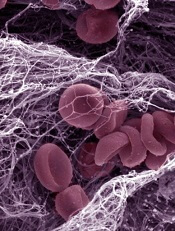
Image by Kevin MacKEnzie
LONDON—A score used to predict the risk of thromboembolic events, ischemic stroke, and death is only modestly accurate in patients with heart failure (HF), according to researchers.
They found the accuracy of the CHA2DS2-VASc score was dependent upon the endpoint being assessed and the duration of follow-up.
The score proved least effective for predicting thromboembolism, and its negative predictive values (NPVs) were inferior at 5 years of follow-up compared to 1 year.
Gregory Y. H Lip, MD, of Aalborg University in Denmark, and his colleagues reported these findings in JAMA and at the ESC Congress 2015 (abstract 1830*).
The team noted that the CHA2DS2-VASc score (congestive heart failure, hypertension, age 75 years or older [doubled], diabetes, stroke/transient ischemic attack/thromboembolism [doubled], vascular disease [prior heart attack, peripheral artery disease, or aortic plaque], age 65-75 years, sex category [female]) is already used clinically for stroke risk stratification in patients with atrial fibrillation (AF).
But its usefulness in a population of patients with HF has been unclear. So the researchers investigated whether CHA2DS2-VASc predicts ischemic stroke, thromboembolism, and death in patients with a new diagnosis of HF, with or without AF.
Using Danish registries, the researchers compiled data from 42,987 patients (22% with concomitant AF). The patients were not receiving anticoagulation and had been diagnosed with new-onset HF from 2000 to 2012.
The end of follow-up was December 31, 2012. Levels of the CHA2DS2-VASc score (based on 10 possible points, with higher scores indicating higher risk) were stratified by the presence of AF at study entry.
Among patients without AF, the incidence of thromboembolism was 3.5%, the rate of ischemic stroke was 1%, and the death rate was 7.2%. Among patients with AF, the rates were 4.2%, 2%, and 13.2%, respectively.
Predictive accuracy
For predicting thromboembolism in patients without AF, the C statistics were 0.63 at 1 year and 0.67 at 5 years. The NPVs were 88% and 73%, respectively.
For predicting thromboembolism in patients with AF, the C statistics were 0.62 at 1 year and 0.69 at 5 years. The NPVs were 88% and 61%, respectively.
For predicting ischemic stroke in patients without AF, the C statistics were 0.67 at 1 year and 0.69 at 5 years. The NPVs were 92% and 78%, respectively.
For predicting ischemic stroke in patients with AF, the C statistics were 0.64 at 1 year and 0.71 at 5 years. The NPVs were 91% and 69%, respectively.
For predicting death in patients without AF, the C statistics were 0.64 at 1 year and 0.68 at 5 years. The NPVs were 93% and 81%, respectively.
For predicting death in patients with AF, the C statistics were 0.63 at 1 year and 0.70 at 5 years. The NPVs were 94% and 76%, respectively.
Based on these results, the researchers said the clinical usefulness of the CHA2DS2-VASc score for patients with HF remains to be determined. And preventative strategies to reduce thromboembolism and ischemic stroke among these patients require further investigation.

*Information in the abstract differs from that presented.

